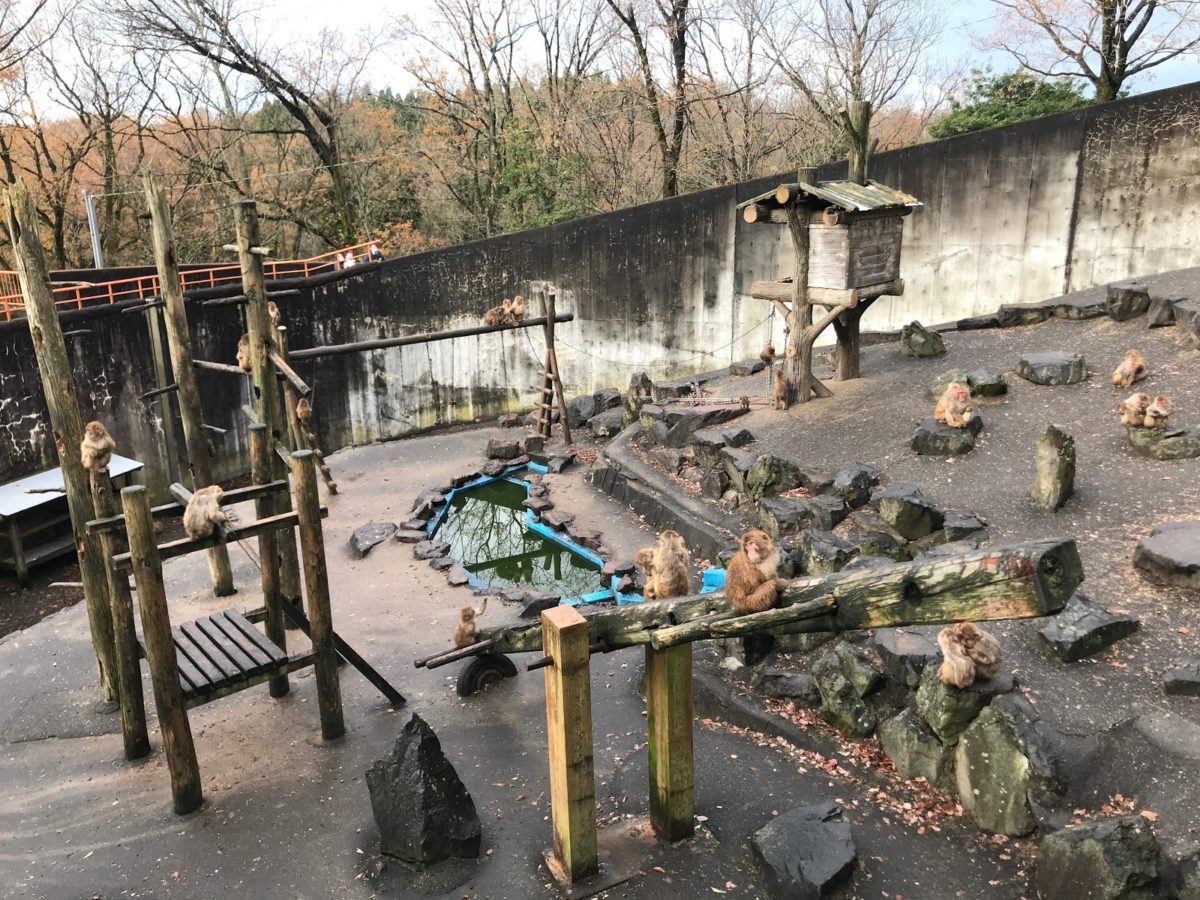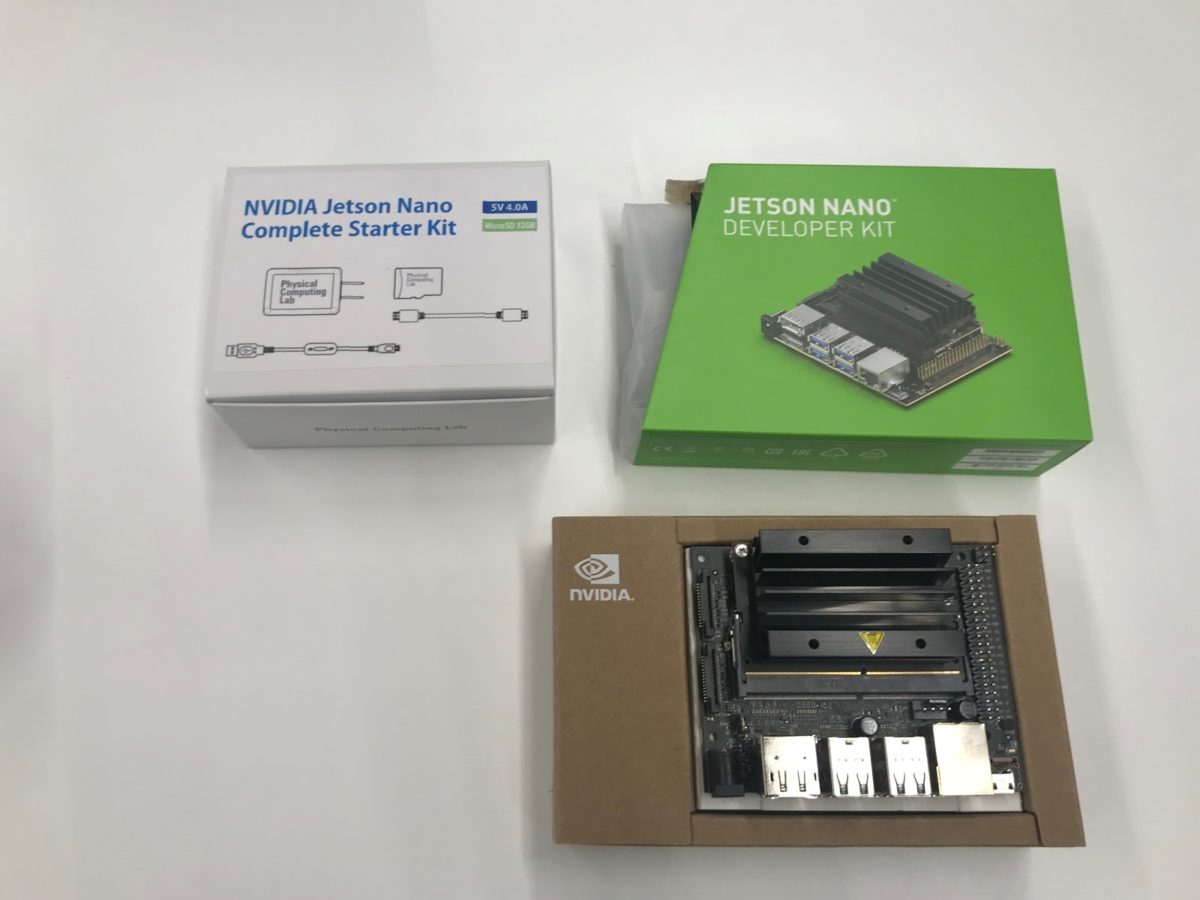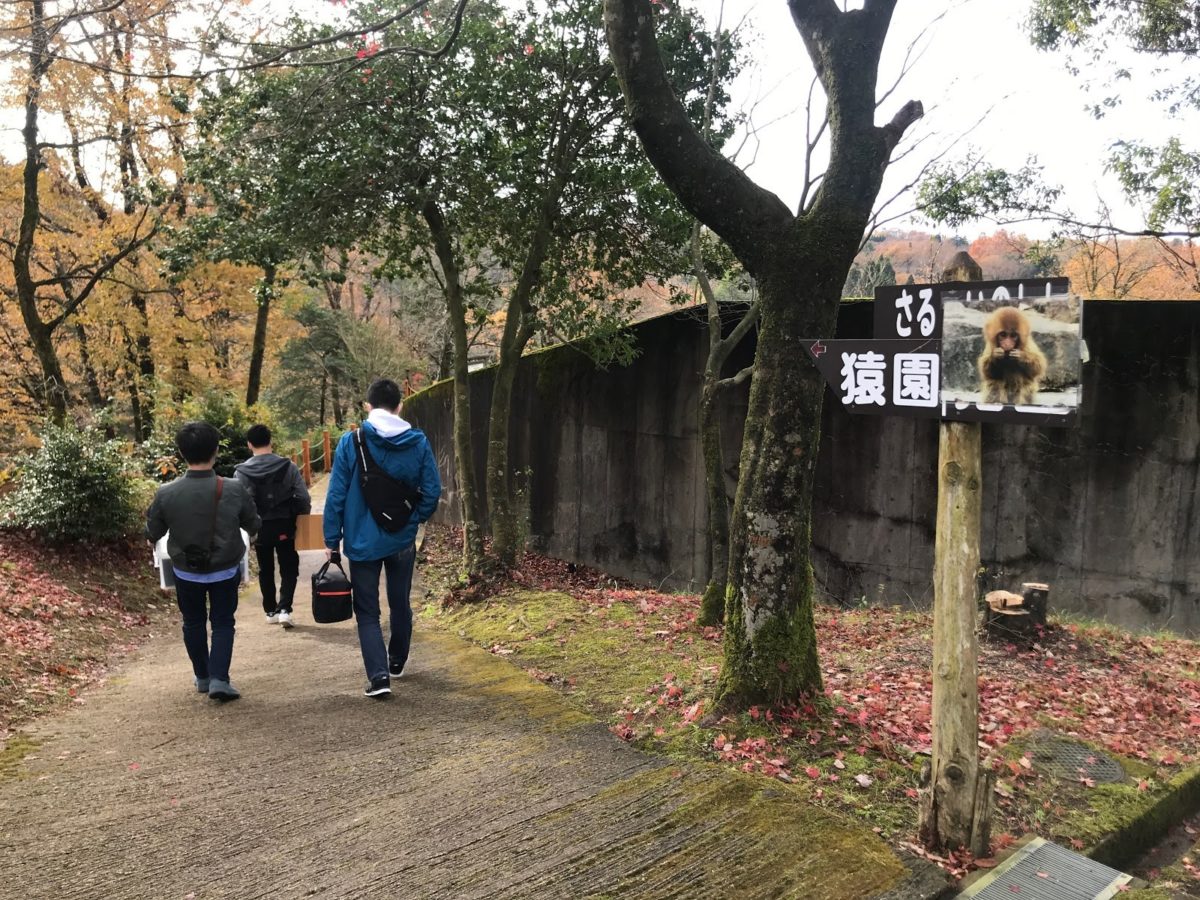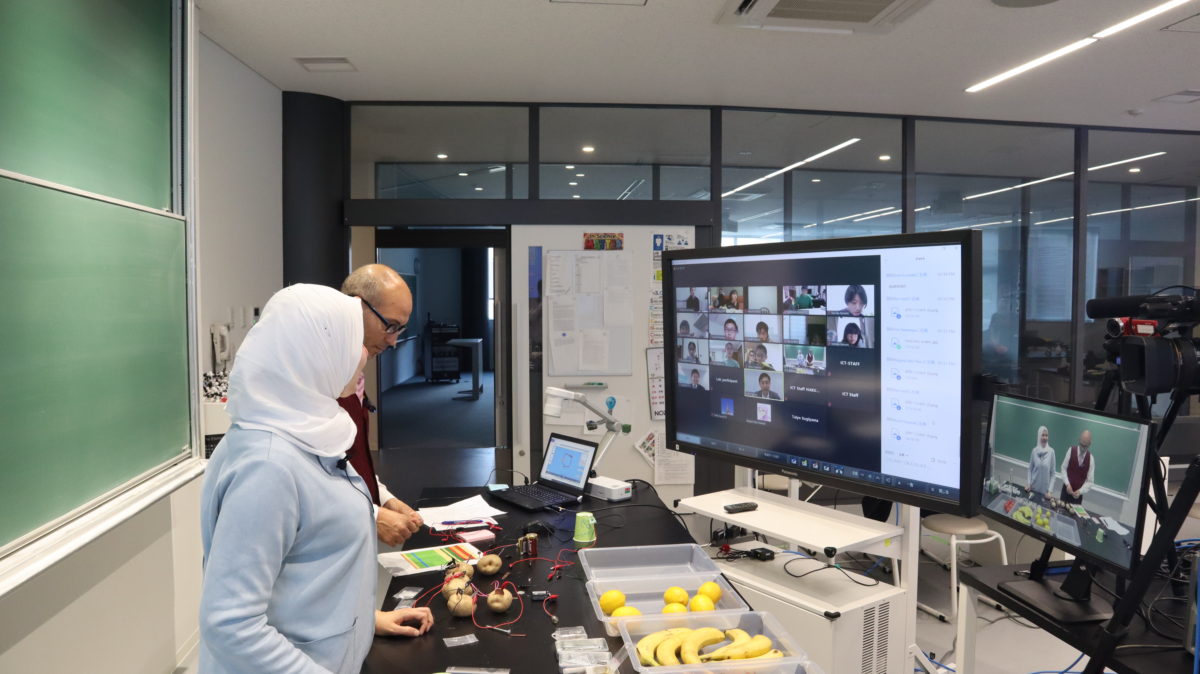 Hi, it's Jonathan, the camera man. Today I would like to give a report about the final presentations for the first year students' Engineering Design 1B projects held on January 16. Engineering Design is the class in which students design solutions for problems within their local community. Students were divided into three groups and given the task of creating a prototype that helped their respective target group. The three targets were the security staff, cleaning staff, and onsen staff. Also, the prototype must be made using LEGO EV3 and biomimicry, which is the method of implementing characteristics of nature or animals into your project. Each group interviewed their target to understand their needs before deciding on what to create.
Hi, it's Jonathan, the camera man. Today I would like to give a report about the final presentations for the first year students' Engineering Design 1B projects held on January 16. Engineering Design is the class in which students design solutions for problems within their local community. Students were divided into three groups and given the task of creating a prototype that helped their respective target group. The three targets were the security staff, cleaning staff, and onsen staff. Also, the prototype must be made using LEGO EV3 and biomimicry, which is the method of implementing characteristics of nature or animals into your project. Each group interviewed their target to understand their needs before deciding on what to create.
In the beginning of this semester, the students started by learning how to use LEGO EV3. LEGO EV3 is a robotic kit that you can customize and program. This took several weeks as the students learned how to build the blocks and gears, and program the robot to move as intended. They were given multiple courses that the robots had to complete. There was much trial and error as the students learned the fundamentals of robot programming. The pictures above were taken last October.
These are pictures of students a few days before the final presentation. Students learned how difficult time management is the hard way. All teams had to crunch after school to meet the deadline.
Security Staff Group "Sanitaika"
The security staff group learned from their interview that the guards had trouble noticing when visitors came into the building because they do not have a direct view of the entrance from their office. To solve this problem, the students designed a machine that detects and notifies the guards whenever the automatic doors open. The animal they mimicked was the firefly squid (famous in Toyama prefecture). The machine lights up to tell visitors where to go and also has an automatic hand sanitizer function. The students emphasized in their presentation that the wished to add a "fun element" to liven up the security staff's working environment. In this case, they designed a rotating mechanism that shows a man running through trees of the four seasons each time the sensor detects a visitor.
Cleaning Staff Group "Gommit"
The group that targeted the Hakusanroku Campus cleaning staff concluded from their interview that they should show more gratitude to the cleaning staff and make their jobs more enjoyable. To achieve this, they designed a machine attached to one of the garbage bins. They installed a sensor that detects how many times trash is thrown into the bin and a fan that opens depending on how full the garbage bin is. This fan is the group's biomimicry idea taken from the peacock. This is a visual indication of how full the garbage bin is. However, this is not the only function. When opening the garbage bin to remove the garbage bag, one of three stuffed animals will appear and make a sound. The animals and sounds are random so that the cleaning staff can enjoy this feature each time they use it.
Onsen Staff Group "EV8"
The final group was the most aesthetically pleasing onsen staff group. Hakusanroku Campus has an onsen facility and this groups goal was to create something that would benefit the staff there. After interviewing the maneger and staff, the group learned that they desired to know if and how much the customers enjoyed their experience. To fulfill this, the group designed a machine that lets customers easily give their feedback. There are four sensors on the front of the base, which represent "Great" to "bad". (they plan to add smiley faces in the final version) Feedback is recorded on a memory card, so the onsen staff can view and keep track of the results. Also, a flower will bloom every five times a customer gives positive feedback. Since this machine will be installed in the onsen, students focused on aesthetics as well. They created two dioramas representing the seasons of Hakusanroku's landscape and gave the whole box a clean look.
All three groups' ideas and prototypes were unique and fascinating. They were well thought out and I could see how they improved their project from their first prototype to the second and final version. This is also why I could not help seeing room for improvement. The presentations were in English, which the Japanese students have still to master. Still, they could have been much better with practice. Also, each team needed to work until the last moment; which was a shame because they were all great! I am definitely planning to use this day as a mental waypoint to look back on and see how much they have grown in the future.
Jonathan
こんにちは、カメラマンのジョナサンです。今日は1月16日に行われた1年生のエンジニアリングデザインIBのプロジェクト最終発表について書きたいと思います。エンジニアリングデザインは学生たちが身の回りの課題を発見し、解決策を創出する授業です。今回は3つのグループに分けられ、それぞれ警備員、清掃員、温泉スタッフの3つの対象に向けた課題解決のプロトタイプ製作を目標としました。プロトタイプはLEGO EV3で作られ、自然界からヒントを得るバイオミミクリーをプロジェクトに取り組まなければなりません。各グループはそれぞれの対象顧客へのインタビューから活動を開始しました。
学期はじめ、1年生はLEGO EV3について勉強しました。LEGO EV3はカスタマイズ性があり、プログラミングで動かすことのできるロボットのキットです。学生たちは数週間かけてブロックの組み合わせ方や意図通りにロボットを動かすプログラミングの練習をしました。複数の課題やコースが用意され、学生たちは試行錯誤しながらクリアしていきました。写真は去年の10月に撮った時の様子です。
次の写真は最終発表が行われる1月16日の前日までプロトタイプ製作に励む学生たちの様子です。どれほど時間管理に気を配ったつもりでも、ギリギリになってしまう経験は皆さんもあるのではないでしょうか。ここでは、放課後に残業する学生たちの姿がありました。
警備員グループ「Sanitaika」
警備員グループはインタビューの中で、玄関が警備員室から死角になっているせいで、訪問者に気付かないことがある課題を知りました。これを解決するために自動ドアが開いた時に知らせてくれる装置を考えました。取り入れたバイオミミクリーは富山県で有名なホタルイカで、青く光って訪問者に場所を知らせる機能があります。また、センサーが反応して消毒液が出る機能もあります。学生たちはこれに加えて警備員たちの仕事を楽しくする要素を加えたかったと述べ、ただ光や音で知らせるのはではなく、四つの季節を現した木々が描かれた丸いアクリル板を製作し、訪問者が来た時に回転して中央の人間が季節の中を走っているように見せる遊びを加えました。
清掃員グループ「Gommit」
白山麓キャンパスの清掃員を対象にしたグループはインタビューをして、感謝の気持ちをより伝えるとともに、仕事を楽しくするプロジェクトを考えました。思いついたのはごみ箱に取り付ける装置です。内部のセンサーがごみを感知し、投げ込まれた数を数えます。それに合わせてうしろの扇子が開いてゆき、15回で満開になります。これによって清掃員は確認せずともごみの溜まり具合がわかるという仕組みです。扇子は孔雀から取ったバイオミミクリーのアイデアです。しかし、このロボットの機能はこれだけではありません。ごみ袋を取り出すために扉を開けると、動物の声とともにぬいぐるみの顔が現れるようになっています。しかも、動物は猫、猿、ひよこの3種類あり、どの声と動物が出現するかはランダムとなっていて、清掃員が長く楽しめる配慮がされています。
温泉スタッフグループ「EV8」
最後のグループは見た目も美しい温泉スタッフグループでした。白山麓キャンパスには温泉施設が隣接されています。スタッフに話を聞くと、お客さんの感想をもっと知りたがっていることがわかりました。これを叶えるために学生たちは温泉に入った人が簡単に感想のフィードバックができる装置を製作しました。装置の正面には四つのセンサーがあり、それぞれ「とても良かった」~「良くなかった」の感想レベルを表しています。(最終版にはニコニコ顔などが表示される予定だそうです)お客さんの感想はメモリーカードにデータ化され、パソコンに取り込むことによって確認したり、記録したりすることができます。また、良い感想を5回検知すると、モーターが回転して上部のジオラマに花が咲くようになっています。そして、ほかのグループと違って公共の場に置くため、外観にも力を入れました。上部には白山麓の季節を現した2つのジオラマがあり、箱自体もすっきりとした見た目になっています。
いずれのプロジェクトも個性的で、素晴らしいものでした。インタビューをしてからじっくり考え、最初のプロトタイプから行った改善点がよく見えました。もちろん、成長の余地もあったように思えました。発表は英語で行う必要があったとはいえ、練習次第ではもっと上達すると感じました。また、発表直前まで追い込み作業をしているグループが目立ち、時間管理の難しさを痛感したはずです。素晴らしいプロジェクトだったからこそ、きっと悔しい思いと思います。今後、彼らの5年間の成長を見守っていく中で、今回の発表をひとつの懐かしい比較点として心に留めておこうと思います。
ジョナサン

 Hello everyone, Welcome back to the journey (^o^)//. As you follow Hakusanroku Journal, The group of second-year students has been doing in Engineering Design class. Some of the students planted sweet potatoes in the garden across the campus. Unfortunately, The monkey gangsters stole the lovely sweet potatoes from the students.
Hello everyone, Welcome back to the journey (^o^)//. As you follow Hakusanroku Journal, The group of second-year students has been doing in Engineering Design class. Some of the students planted sweet potatoes in the garden across the campus. Unfortunately, The monkey gangsters stole the lovely sweet potatoes from the students.
Following this journal : https://www.ict-kanazawa.ac.jp/journal/12370/
皆さん、こんにちは。旅路へおかえりなさい(^o^)// 白山麓ジャーナルを普段から読んでいる方は、2年生のグループによるエンジニアリングデザインの活動について読んだことがあるでしょう。キャンパスの向かいの畑にさつまいもを植えた学生のグループがいます。しかし、残念ながら愛情を込めたさつまいもは猿のギャングによって盗まれてしまいました。

However, The “Agri-tech” group decided to create a system that can detect the monkey by using Artificial Intelligence (AI). They went to Ishikawaken Shinrin Koen Forest Zoo in Tsubata-machi and took photos of monkeys for teaching a machine (Machine Learning : ML) to recognize the monkey.
これを受けて、「アグリテック班」は人工知能(AI)を利用して猿を検知できるシステムの制作を決意しました。津幡町にある石川県森林公園の動物園で猿の写真を撮って、機械に学習させました。(機械学習=ML)
In my part, I have been used to Machine Learning before. Then, I suggest the student use the Jetson nano development board for their project. Jetson nano is a Small, Powerful computer for makers, learners, and developers. It’s easy to get started building practical AI Applications.
私は以前にも機械学習をしたことがありましたので、学生たちにJetson nano development boardを使うように勧めました。Jetson nanoはエンジニア、学生、開発者用に作られた小型ながらパワフルなコンピューターです。AIを使った実用的なアプリケーションを初めて作る人に適しています。
After the students took a Thousand monkey photos, We had to supervise the machine to recognize the monkey. We start designing the system and labeling all the images where the monkeys are in the photos.
猿の写真を千枚撮ったら、次は機械が猿を見分けられるように手助けしなければなりませんでした。ここではシステムを設計して写真の中の猿にラベルを付けました。
The students spend a couple of weeks training a model that uses 100 images, 200 images, 300 images, and increasing to 1500 images and So on.
学生たちは数週間かけて、100枚、200枚、300枚…1500枚…と枚数を増やしていきました。

Finally, We got a model that is high accuracy and satisfied.
ようやく満足できる高い認識率を達成できました。
We went back to Forest park again and tested our machine. As you can see in the video, The system can detect real-time and count the monkeys by using a USB camera.
完成したモデルを持って森林公園に戻り、試験を行いました。下の動画で見てわかるように、システムがUSBカメラに映った猿をリアルタイムで認識して数えています。
In the future, The students plan to make a box cover the device and install the machine in their garden to protect our sweet potatoes from the monkey.
将来的にはデバイスを収納する箱を作って、畑に設置してさつまいもを猿から守りたいです。
Apirak Sang-ngenchai
アピラク・サンゲンチャイ
+++
電気学会 U-21 学生研究発表会で最優秀賞受賞
学生3名はSDGsをテーマにこの研究を電気学会「U-21学生研究発表会」で発表し、見事、最優秀賞を受賞しました。詳しくはこちら。
 Hello everyone, Jomkit here with my very first journal entry! It’s been a few weeks since I started working here, but the beauty of nature still astounds me. I am not much for photography, but when I see the landscape surrounding us I can’t help but try and capture it on my phone. I’m no stranger to towering mountain ranges and trees that carpet them, but in my hometown of Portland, Maine, I would need to drive 45 minutes out of the city to see such magnificence. Here, all it takes is one glance out the window and I’m faced with a visage painted by the turning of the seasons.
Hello everyone, Jomkit here with my very first journal entry! It’s been a few weeks since I started working here, but the beauty of nature still astounds me. I am not much for photography, but when I see the landscape surrounding us I can’t help but try and capture it on my phone. I’m no stranger to towering mountain ranges and trees that carpet them, but in my hometown of Portland, Maine, I would need to drive 45 minutes out of the city to see such magnificence. Here, all it takes is one glance out the window and I’m faced with a visage painted by the turning of the seasons.
With that being said, the Hakusan area is much quieter than what I’m used to. Growing up I lived in the city next to a hospital, so there were many nights where I fell asleep in conditions some people would consider too noisy to think. But I’m getting used to the calmness of the rural area, and there’s certainly a few sights to see. One thing that has helped me deal with homesickness is walking to the nearby coffee shops, such as Kijitora or Koubou. I absolutely love trying new coffee, and neither of these places have disappointed. Kijitora’s style is delightfully reminiscent of the cafes in my hometown, and they have a fantastic selection of espresso drinks. Koubou on the other hand may only offer a limited selection of drink styles, but their cozy seats and warm atmosphere really makes you lose track of time. The homemade baked goods are likewise delightful. I’ve heard the coffee scene in Ishikawa is bustling, so I look forward to getting to know the specialties of local shops and roasters.
Jomkit Jujaroen
はじめまして。ジョムキット先生の最初の白山麓ジャーナルですよ!ここで働き始めてから数週間が経ちましたが、いまだに周辺の自然の美しさに驚かされます。写真は得意じゃありませんが、周りの地形を見るとスマホのカメラ機能で捉えようとしたくなります。そびえたつ山麓や生い茂る森林は私の故郷のメーン州のポートランドにもあるのですが、見るためには市外へ45分は運転しないといけません。ここでは窓の外をのぞくだけで季節に彩られた風景画が目に飛び込んできます。
それはそうと、白山麓は故郷よりずっと静かでもあります。町中の病院の隣の家に生まれ育った私は、人によってはとても眠れないような光と騒音の中眠りにつくことに慣れています。しかし、人里離れたここの静けさに馴染んできました。ホームシックを紛らわせるためによくしているのはキジトラコーヒー研究所や珈琲KOUBOUなどのカフェまで散歩することです。新しいコーヒーを試すのは大好きで、いずれの店も納得の美味しさです。キジトラは故郷のコーヒーを思い出させてくれる素敵な味ですし、エスプレッソの種類が豊富です。KOUBOUは飲み方のバリエーションこそ少ないですが、温かみのある雰囲気が時間を忘れさせてくれます。手作りの焼き菓子も最高です。石川県はコーヒーに熱い県と聞いていますので、地元の店やロースターを回るのが楽しみです。
ジョムキット・ジュジャロエン
 Hello everyone! My name is Brandon Wohlfarth and I just started teaching here at ICT, so this is my first Hakusanroku Journal entry. Since arriving at the Hakusanroku campus I have been blown away by the wonderful scenery surrounding campus. The mountains reaching up towards the sky, the rich reds and browns that mark the fall season, have all impressed me.
Hello everyone! My name is Brandon Wohlfarth and I just started teaching here at ICT, so this is my first Hakusanroku Journal entry. Since arriving at the Hakusanroku campus I have been blown away by the wonderful scenery surrounding campus. The mountains reaching up towards the sky, the rich reds and browns that mark the fall season, have all impressed me.
The natural landscape of the Hakusanroku campus is a stark contrast from many of the locations that I have lived in the United States. I attended Rose-Hulman Institute of Technology located in Terre Haute, Indiana where I received both my undergraduate and master’s degree. While I love Indiana, unfortunately the scenery only consisted of flat land used primarily for agriculture. This made outdoor activities such as hiking much less enjoyable. The difference between these two locations is truly like comparing night and day, completely different. After the winter, I am looking forward to being able to hike and explore the various trails in the Hakusan area.
I have been lucky so far that the weather has been pleasant so that I can still take the opportunity to enjoy nature before the snow and cold comes in. I have enjoyed walking around the Hakusanroku campus and the surrounding area. I am excited to see how the natural landscape surrounding us changes as the seasons progress, and in what other ways it may differ from what I have experienced in the past. Below are some of the pictures of the surrounding area that I have taken so far. I am not the greatest photographer so bear with me. Over the last few weeks it has been wonderful meeting the students, faculty, and staff members here at ICT. I look forward to working with everyone!
Brandon Wohlfarth
はじめまして!国際高専に着任したばかりのブランドン・ウォルファースと申します。これが最初の白山麓ジャーナルになります。白山麓キャンパスに着いてからというもの、周辺の美しい景色にただただ圧倒されています。山が空へ伸びてゆき、秋を彩る紅や茶色に染まっています。
白山麓キャンパスの周りの自然はアメリカで住んでいた場所とは大きく違います。私はインディアナ州テレ・ホートにあるローズハルマン工科大学で学士と修士号を取りました。インディアナ州の風景も大好きですが、農業に使われている平地がほとんどです。これによりハイキングのようなアウトドアな遊びに適していません。白山麓キャンパスと比べるとその違いは明らかです。暖かくなったら白山のハイキングコースを探索するのが楽しみです。
それでも良い天気が続いているおかげで、寒くなって雪が降る前に自然を楽しむチャンスがありました。これまでは白山麓キャンパス周辺を散歩して楽しんでいます。季節が進む中で、どんな風に景色が変わるのか、そして私が過去に住んだ土地とどう違うのか体験するのが楽しみです。いくつか撮った周辺の写真を載せておきます。あまり写真は得意じゃないので許してくださいね。ここ数週間は国際高専の学生と教職員に会える楽しい時期でした。皆さんと一緒にお仕事するのが楽しみです!
ブランド ウォルファース
 こんにちは、ジョナサンです。2020年11月29日(日)、JOES-ICTオンライン体験型ワークショップが白山麓キャンパスで開催されました。JOES(海外子女教育振興財団)の小中学生を本校に呼んだサマーワークショップを毎年夏に行っていますが、今年はコロナ禍で中止となったため、オンラインでの代替イベントを開催する形となりました。
こんにちは、ジョナサンです。2020年11月29日(日)、JOES-ICTオンライン体験型ワークショップが白山麓キャンパスで開催されました。JOES(海外子女教育振興財団)の小中学生を本校に呼んだサマーワークショップを毎年夏に行っていますが、今年はコロナ禍で中止となったため、オンラインでの代替イベントを開催する形となりました。
イベントは13時に開始され、参加した小学生27名がPCやスマートフォンでログインしました。双方のあいさつと、国際高専の簡単な紹介ビデオのあと、化学を担当するナグワ先生と数学を担当するアラー先生によるワークショップが始まりました。第1部は「Chem-melody」と題され、10円玉と1円玉を塩水につけてスピーカーから音楽を流すという実験で電流の仕組みについて解説しました。クイズも出題され、参加者はZOOMのアンケート機能を使って回答しました。
第2部は「DIY実験 フルーツバッテリー制作」と題され、事前に準備をしていただいたレモン、バナナ、トマトなどのフルーツに刺した様々な金属の釘をケーブルでつないでLEDランプが点灯するかを実験しました。参加者はZOOMのビデオ機能で手元を映して作業をし、ナグワ先生とアラー先生はその様子を見ながら指示を出したり、質問に答えたりしました。映像を見ていると子供たちは待ちきれない様子で、説明を聞くや否や、準備したフルーツにケーブルをつないだり、点灯したLEDランプをカメラにかざして見せたりしていました。第3部の「Interactive Computer Simulation」ではオンライン上で回路を組めるブラウザソフトでオリジナルの回路を作って、スクリーンショットをチャット欄に共有しました。個性的な回路がたくさんあり、ナグワ先生は参加者たちの積極性に感激している様子でした。
オンラインという形になりましたが、ワークショップを開催できてよかったです。来年は対面になるのか、同じくオンライン開催になるかわかりませんが、楽しみにしています。
ジョナサン
Hi, it's Jonathan, the camera man. On November 29 (Sun), 2020, the JOES-ICT Online Workshop was held at the Hakusanroku Campus. We host a summer workshop with Joes (Japan Overseas Educational Services) students every year. However, this year it was cancelled due to the COVID-19 situation, and an online event was created instead.
The online workshop began at one in the afternoon and 27 elementary students logged in from their home. After some opening words from both sides and a short introductory video about ICT, Nagwa sensei and Alaa sensei (in charge of chemistry and math respectively) started the workshop. The first part was titled "Chem-melody." First, Nagwa sensei gave a lecture about how electricity works. Then, she connected 10 yen and 1 yen coins to a speaker and music chip before putting them in salt water; displaying that electrons were in fact traveling through the circuit as music came out of the speaker. There were quiz questions during the experiment which the participating students answered using Zoom's survey function.
In the second part of the workshop, titled "DIY Experiment Fruit Battery Making", Nagwa sensei showed the participants how to make a battery using fruits, such as lemons, bananas and tomatoes. The fruits were connected to a LED lamp via cables and nails made of different metal. Participants had prepared these items in advance and apparently could not wait to do the experiment because we could see them starting even as Nagwa sensei was still giving the instructions. Nagwa sensei and Alaa sensei watched their progress and answered any questions the students had. In the third part, "Interactive Computer Simulation", participants created an original circuit using a browser software, took screenshots of their work and posted it in chat. There were many creative circuits and Nagwa sensei expressed her joy for their enthusiasm.
I'm happy that we were able to continue the tradition of this relationship with JOES, even if it wasn't in the flesh. Hopefully the situation will be more favorable next year.
Jonathan









































